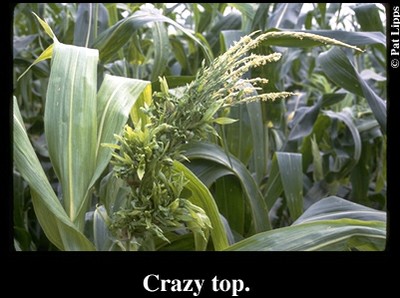Symptoms:
The most characteristic symptom is the proliferation of leafy structures from the ears and/or tassels, In many cases, leafy protrusions occur in only the ears resulting in a mass of strap-like leaves protruding from the ear zone. Affected plants may also have profuse tiller development.
Cause:
Crazy top is caused by the soil borne fungus, Sclerophthora macrospora. Crazy top can be found throughout Ohio but rarely causes substantial losses. The disease develops where soils have been saturated for 24 to 48 hours soon after planting. The fungus infects the growing point of the young corn plants usually before the second or third leaf stage, then grows systemically within the plant and develops in the rapidly growing tissues. The systemic growth causes a hormonal imbalance, which initiates the proliferation of leafy tissue in the ears and tassels.
Management:
No highly effective control measures can be recommended for crazy top. Very little is known about the level of resistance in corn hybrids to this disease. Proper soil drainage will reduce the risk of flooding and subsequent infection. Avoid planting corn in low wet spots where the disease is known to occur. Seed applied fungicides will not control crazy top.
References:
P. E. Lipps and D. R. Mills. 2001. Crazy Top of Corn. Ohio State University Extension Plant Pathology Fact Sheet AC-0034-01.

